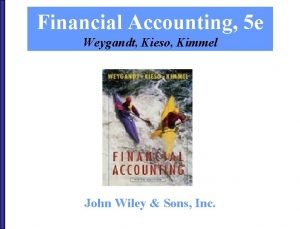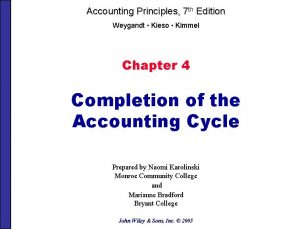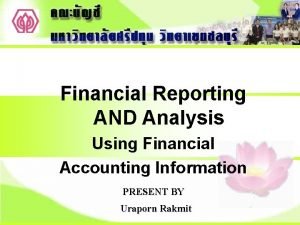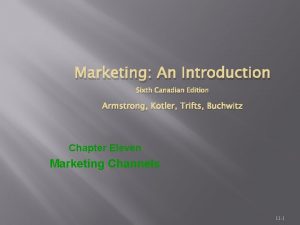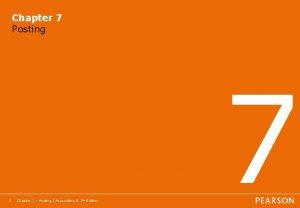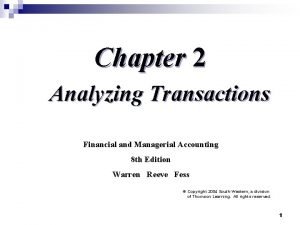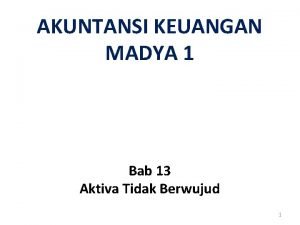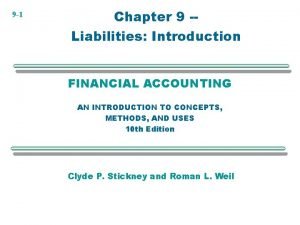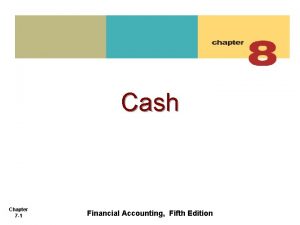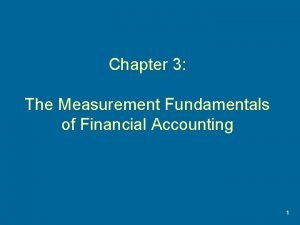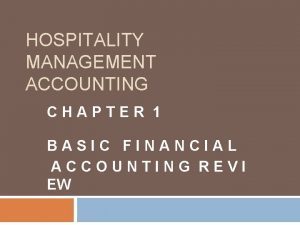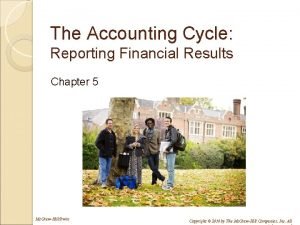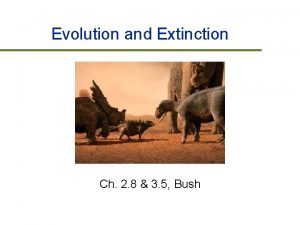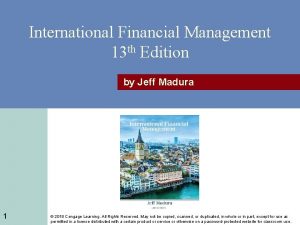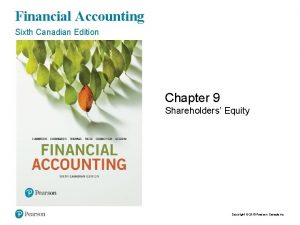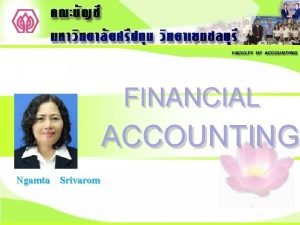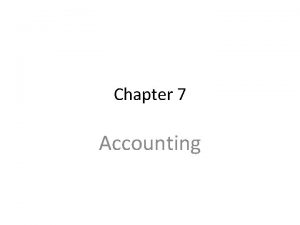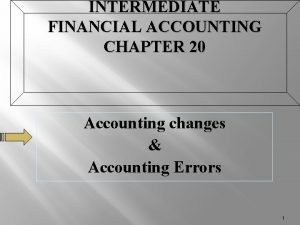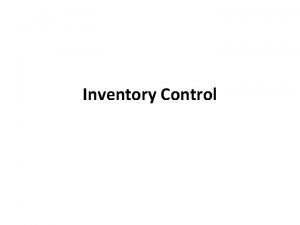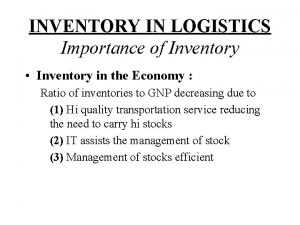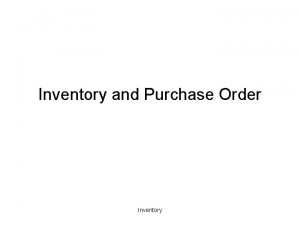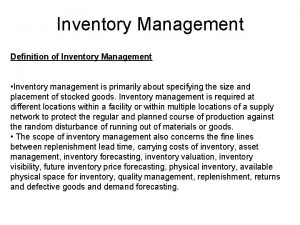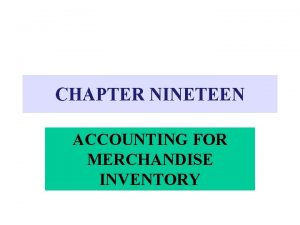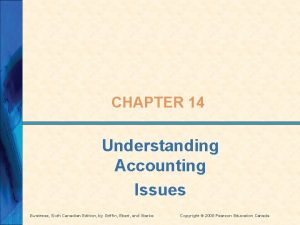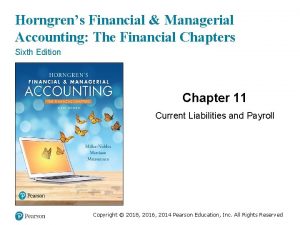Financial Accounting Sixth Canadian Edition Chapter 5 Inventory







































- Slides: 39

Financial Accounting Sixth Canadian Edition Chapter 5 Inventory & Cost of Goods Sold Copyright © 2018 Pearson Canada Inc.

Learning Objective One Account for inventory using the perpetual and periodic inventory systems Copyright © 2018 Pearson Canada Inc.

Income Statements Service Company Merchandising Company Income Statement For the Year Ended December 31, 20 xx Service revenue $XXX Expenses Operating and administrative expense X Depreciation expense X Income tax expense X Net income $ X Sales Revenue $XXX Cost of goods sold XXX Gross profit XXX Operating expenses: X Operating and administrative expense X Depreciation expense X Income tax expense Net income $ X Copyright © 2018 Pearson Canada Inc.

Balance Sheets Service Company Balance Sheet December 31, 20 XX Merchandising Company Balance Sheet December 31, 20 XX Current assets: Cash Current assets: $X Cash $X Short-term investments X Accounts receivable, net X Prepaid expenses X Inventory X Prepaid expenses X Copyright © 2018 Pearson Canada Inc.

Merchandise Inventory Balance Sheet (partial) Current assets: Cash $XXX Accounts receivable XXX Inventory (1 chair @ cost of $300) $300 Income Statement (partial) Sales (2 chairs @ $500 selling price) Cost of goods sold (2 chairs @ $300 cost) Gross profit $1, 000 600 $400 Copyright © 2018 Pearson Canada Inc.

The cost of inventory on hand = Inventory The cost of inventory that’s been sold = Cost of Goods Sold Asset on the Balance Sheet Expense on the Income Statement Copyright © 2018 Pearson Canada Inc.

Sales Price vs. Cost of Inventory • Sales revenue based on sales price of inventory sold • Cost of goods sold based on cost of inventory sold • Inventory based on cost of inventory on hand • Gross profit, also called gross margin – Sales revenue minus cost of goods sold Copyright © 2018 Pearson Canada Inc.

Number of Units of Inventory • Determined from accounting records • Evidenced by physical count at year-end • Consigned goods: – Does not include those held for another company – Does include those out on consignment • In transit goods – Depends on shipping terms Copyright © 2018 Pearson Canada Inc.

Shipping terms FOB Shipping Point FOB Destination • Legal title passes to purchaser when items leave seller’s place of business • Legal title passes to purchaser when items arrive at purchaser’s receiving dock • Purchaser owns good while in transit • Seller owns goods while in transit – Included in purchaser’s inventory count – Included in seller’s inventory count • Seller pays transportation costs • Purchaser pays transportation costs Copyright © 2018 Pearson Canada Inc.

Inventory Accounting Systems Perpetual Inventory System Used for all types of goods Periodic Inventory System Used for inexpensive goods Keeps a running total of all goods bought, Does not keep a running total of all goods sold, and on hand bought, sold, and on hand Inventory counted at least once a year Copyright © 2018 Pearson Canada Inc.

Perpetual Inventory • Bar codes on products provide information to record – Sale of item – Update of inventory record • Two entries needed for each sale – Record revenue and asset received (cash or receivables) – Record cost of sale and reduction of inventory Copyright © 2018 Pearson Canada Inc.

Recording Inventory (Amounts Assumed) (1 of 2) JOURNAL Date Accounts and explanation Inventory Debit Credit 560, 000 Accounts payable 560, 000 Purchased inventory on account Accounts receivable 900, 000 Sales 900, 000 Sold inventory on account Cost of goods sold Inventory 540, 000 Recorded cost of goods sold Copyright © 2018 Pearson Canada Inc.

Recording Inventory (Amounts Assumed) (2 of 2) Inventory Beginning balance 100, 000 Purchases 560, 000 Ending balance 120, 000 Cost of goods sold 540, 000 Cost of Goods Sold Cost of goods sold 540, 000 Copyright © 2018 Pearson Canada Inc.

Reporting in the Financial Statements Balance Sheet (partial) Current assets: Cash $ Accounts receivable Inventory XXX 120, 000 Prepaid expenses XXX Income Statement (partial) Sales Cost of goods sold Gross profit $900, 000 540, 000 $360, 000 Copyright © 2018 Pearson Canada Inc.

Cost of Net Purchases Purchase price of the inventory + Freight-in − Purchase returns − Purchase allowances − Purchase discounts = Net purchases of inventory $600, 000 4, 000 (25, 000) (14, 000) $ 560, 000 Copyright © 2018 Pearson Canada Inc.

Net Sales revenue − Sales returns and allowances − Sales discounts = Net sales Copyright © 2018 Pearson Canada Inc.

Learning Objective Two Apply and compare three inventory costing methods Copyright © 2018 Pearson Canada Inc.

Inventory Costing Methods Specific identification cost Average cost First-in, first-out Copyright © 2018 Pearson Canada Inc.

Specific Identification Cost • Used for businesses with unique inventory items – Automobiles, antique furniture, jewels, and real estate • Businesses cost their inventories at the specific cost of the particular unit • Too expensive for inventories with common characteristics Copyright © 2018 Pearson Canada Inc.

Average Cost *Goods available = Beginning inventory + Purchases Copyright © 2018 Pearson Canada Inc.

First-in, First-out (FIFO) • Oldest items assumed to be sold first • Ending inventory consists of most recent purchase costs Copyright © 2018 Pearson Canada Inc.

Illustration of Weighted Average and FIFO Costing (1 of 2) Leon’s began the period with 10 lamps that cost $10 each; the beginning inventory was therefore $100. During the period, Leon’ s bought 50 more lamps, sold 40 lamps, and ended the period with 20 lamps. Inventory Beginning bal. (10 units @ $1 ) $100 Purchases: Cost of goods sold: (40 units @ $? ) No. 1 (25 units @ $14) $350 No. 2 (25 units @ $18) 450 ? Total cost ($100 + $350+$450=$900) Ending bal. (20 units @ $? ) ? Copyright © 2018 Pearson Canada Inc.

Illustration of Weighted Average and FIFO Costing (2 of 2) The big accounting questions are: 1. What is the cost of goods sold for the income statement? 2. What is the cost of the ending inventory for the balance sheet? Copyright © 2018 Pearson Canada Inc.

Weighted-Average $900 total cost ÷ 60 units = $15/unit Cost of goods sold = 40 × $15 = $600 Ending inventory = 20 × $15 = $300 Copyright © 2018 Pearson Canada Inc.

First-In, First-Out (1 of 2) Ending inventory cost 60 units Less units sold 40 Ending inventory 20 units × $18 per unit = $360 Copyright © 2018 Pearson Canada Inc.

First-In, First-Out (2 of 2) Sold 40 units: 10 from the first group purchased, 25 from the second group, and 5 from the remaining 25 that were purchased. 10 Units @ $10 25 Units @ $14 5 Units @ $18 Copyright © 2018 Pearson Canada Inc.

When inventory costs are INCREASING Weighted Average cost of goods sold is higher because it is based on the average of the costs for the period. Gross profit is the lower FIFO cost of goods sold is lower because it is based on the oldest costs. Gross profit is the higher Copyright © 2018 Pearson Canada Inc.

Learning Objective Three Explain how accounting standards apply to inventory Copyright © 2018 Pearson Canada Inc.

The Principle Related to Inventory Comparability Copyright © 2018 Pearson Canada Inc.

Comparability • Investors want to compare a company’s financial statements from one period to the next • Therefore, must use the same accounting method for inventory from one period to the next • If a change in accounting method can be justified, a change can be made, but prior statements need to be adjusted Copyright © 2018 Pearson Canada Inc.

Lower-of-Cost-and-Net-Realizable-Value Rule • Inventory is reported at the lower of: – Cost or – Net Realizable Value § Usually replacement cost • If market is lower, inventory is written down JOURNAL Date Accounts and explanation Debit Credit Cost of Goods Sold Inventory Wrote inventory down to market value Copyright © 2018 Pearson Canada Inc.

Learning Objective Four Compute and evaluate gross profit and inventory turnover Copyright © 2018 Pearson Canada Inc.

Gross Profit Percentage Copyright © 2018 Pearson Canada Inc.

Inventory Turnover (Beginning Inventory + Ending Inventory)/2 Copyright © 2018 Pearson Canada Inc.

Learning Objective Five Analyze the effects of inventory errors Copyright © 2018 Pearson Canada Inc.

Effects of Inventory Errors (1 of 2) Period 1 Inventory Error Cost of Goods Sold Period 2 Gross Profit Cost of and Net Income Goods Sold Gross Profit and Net Income Period 1 Ending inventory overstated Understated Overstated Understated Overstated Period 1 Ending inventory understated Copyright © 2018 Pearson Canada Inc.

Effects of Inventory Errors (2 of 2) Period 1 Ending Inventory Overstated by $5, 000 Sales revenue $100, 000 Period 2 Beginning Inventory Overstated by $5, 000 Period 3 Correct $100, 000 Cost of goods sold: Beg. inventory $10, 000 $15, 000 $10, 000 Purchases 50, 000 Cost of goods available for sale $60, 000 $65, 000 $60, 000 Ending inventory (15, 000) (10, 000) Cost of goods sold Gross margin 45, 000 50, 000 $ 55, 000 $ 45, 000 $ 50, 000 Copyright © 2018 Pearson Canada Inc.

Ethical Considerations Managers of companies whose profits do not meet shareholder expectations are sometimes tempted to “cook the books” to increase reported income. What are some possibilities? 1. Overstating ending inventory 2. Creating fictitious sales revenue Copyright © 2018 Pearson Canada Inc.

End of Chapter Five Copyright © 2018 Pearson Canada Inc.
 Accounting principles second canadian edition
Accounting principles second canadian edition Accounting principles second canadian edition
Accounting principles second canadian edition Accounting principles second canadian edition
Accounting principles second canadian edition Accounting principles second canadian edition
Accounting principles second canadian edition Inicum
Inicum The sixth sick sheik's sixth sheep's sick lyrics
The sixth sick sheik's sixth sheep's sick lyrics Financial accounting ifrs 4th edition chapter 12
Financial accounting ifrs 4th edition chapter 12 Intermediate accounting chapter 1
Intermediate accounting chapter 1 Kimmel accounting 5e
Kimmel accounting 5e Kimmel financial accounting 7the edition
Kimmel financial accounting 7the edition Using financial accounting information 10th edition
Using financial accounting information 10th edition Biochemistry sixth edition
Biochemistry sixth edition Computer architecture a quantitative approach sixth edition
Computer architecture a quantitative approach sixth edition Automotive technology principles diagnosis and service
Automotive technology principles diagnosis and service Automotive technology sixth edition
Automotive technology sixth edition Citation sample pdf
Citation sample pdf Computer architecture a quantitative approach sixth edition
Computer architecture a quantitative approach sixth edition Precalculus sixth edition
Precalculus sixth edition Principles of economics sixth edition
Principles of economics sixth edition Computer architecture a quantitative approach sixth edition
Computer architecture a quantitative approach sixth edition Marketing an introduction 6th canadian edition
Marketing an introduction 6th canadian edition Sujata madan
Sujata madan Fundamentals of corporate finance canadian edition
Fundamentals of corporate finance canadian edition Social responsibility accounting ppt
Social responsibility accounting ppt Canadian institute of financial planning
Canadian institute of financial planning Accounting 1 7th edition chapter 7
Accounting 1 7th edition chapter 7 Using mis 10th edition
Using mis 10th edition Report
Report Chapter 2 solutions managerial accounting
Chapter 2 solutions managerial accounting Financial accounting chapter 13
Financial accounting chapter 13 Accounting chapter 6
Accounting chapter 6 Financial accounting chapter 9
Financial accounting chapter 9 Financial accounting chapter 7
Financial accounting chapter 7 Financial accounting chapter 3
Financial accounting chapter 3 What is owners equity in accounting
What is owners equity in accounting Hospitality managers are held responsible primarily for:
Hospitality managers are held responsible primarily for: Financial accounting chapter 5
Financial accounting chapter 5 The sixth extinction chapter 3 summary
The sixth extinction chapter 3 summary International financial management jeff madura ppt
International financial management jeff madura ppt Expanded opportunity set international finance
Expanded opportunity set international finance








